Scarlet Tanager
- December 17, 2023
- 0 comment
The Scarlet Tanager (Piranga olivacea) is a medium-sized songbird belonging to the family Cardinalidae. The species is known for its vibrant red plumage, which is characteristic of breeding males. Females and non-breeding males, on the other hand, display olive-green to yellowish plumage. These tanagers are primarily found in deciduous and mixed forests throughout eastern North America during the breeding season. Their diet consists of insects, fruits, and berries.
Physical Appearance

Scarlet Tanager
- Lifespan: 5-8 years
- Habitat: Deciduous and mixed deciduous-evergreen forests
- Diet: Insects, such as caterpillars, beetles, and butterflies, Also eats fruits, berries, and seeds
- Size: 17-20 cm
- Weight: 26-37 grams
- Wingspan: 28-33 cm
- Conservation Status: Least Concern
- Population Trend: Population Stable
The Scarlet Tanager’s physical appearance is striking and memorable, with the contrast between the male’s fiery red and the female’s olive-yellow making it a unique and beautiful bird to observe.
Species Type of Scarlet Tanager
The Scarlet Tanager (Piranga olivacea) is a species of songbird belonging to the family Cardinalidae. Specifically, it falls within the genus Piranga. This species is known for its striking plumage, with males exhibiting bright red colors during the breeding season, while females and non-breeding males display more subdued olive-green to yellowish hues. The Scarlet Tanager is a migratory bird found in North America, particularly in deciduous and mixed forests.

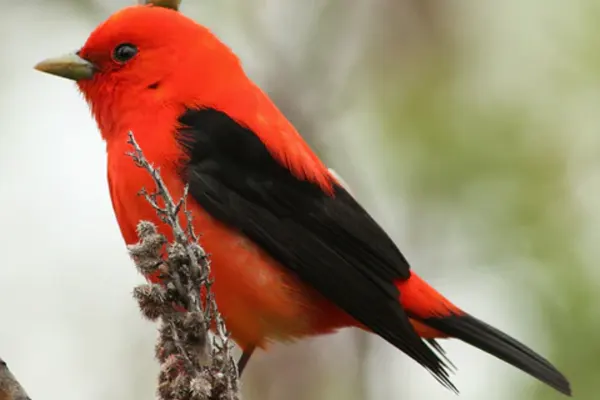
The Scarlet Tanager has been classified in different families throughout its taxonomic history. Previously, it was placed within the tanager family (Thraupidae) but was recently moved to the Cardinalidae family based on genetic studies.
Feather Coloration of Scarlet Tanager
The feather coloration of the Scarlet Tanager is a remarkable combination of beauty and function, serving crucial roles in reproduction, survival, and social interactions.

Male
- Brilliant red: This stunning color dominates the entire body, excluding the wings and tail. It arises from carotenoid pigments obtained through their diet, primarily insects rich in these chemicals.
- Black wings and tail: These bold black feathers provide a sharp contrast to the vibrant red plumage, creating a striking visual effect. The melanin pigment responsible for this color is produced naturally by the bird’s body.
- Red intensity variations: The intensity of the red coloration can vary slightly between individuals, potentially influenced by factors like diet and health.
Female
- Olive-yellow: The overall body plumage is a duller and more muted shade of olive-yellow compared to the male’s vibrant red. This coloration comes from a combination of melanin and carotenoid pigments, resulting in the distinct yellowish hue.
- Darker green wings and tail: Similar to the male, the wings and tail feathers are darker green, creating a contrasting pattern against the olive-yellow body.
- Yellow underparts: The belly and underside of the female often have a more yellowish tinge compared to the rest of the plumage.

The distinct color differences between males and females serve various purposes, including attracting mates for breeding and providing effective camouflage for nesting and foraging, depending on the season.
Flight Characteristics of Scarlet Tanager
The flight characteristics of the Scarlet Tanager are adapted to their arboreal habitat, where they can efficiently move through the forest canopy while foraging and navigating their environment.
- Direct Flight: Scarlet Tanagers are known for their direct and swift flight. They can cover short to moderate distances with agility, flying between trees and through the forest canopy.
- Undulating Flight: Like many songbirds, Scarlet Tanagers may exhibit an undulating flight pattern, where they move in a series of rising and falling arcs. This type of flight helps them navigate through varied terrains and vegetation.
- Quick Maneuvering: They are capable of quick and agile maneuvers, useful for catching insects mid-air or navigating through dense foliage in their woodland habitats.
- Migratory Flight: Scarlet Tanagers undertake long-distance migrations between their breeding grounds in North America and wintering grounds in Central and northern South America. During migration, they often fly at night, guided by the stars.
- Group Behavior: While migrating, Scarlet Tanagers may form loose flocks with other migratory birds. This behavior provides some advantages, such as improved navigation and protection against predators.

- Wing morphology: Short, broad wings: These provide the Scarlet Tanager with excellent maneuverability and agility, allowing it to dart and weave through branches and leaves with ease.
- High wing loading: This means the bird has a larger body mass compared to its wing size. This allows for powerful, direct flight, especially during short bursts of acceleration.
- Stiff, pointed wingtips: These contribute to the bird’s ability to make sharp turns and control its flight path precisely.
- Flight styles: Undulating flight: This is the most common flight style, characterized by a series of shallow ups and downs. This allows the Scarlet Tanager to scan its surroundings and efficiently search for prey.
- Gliding: The Scarlet Tanager will occasionally glide on air currents, particularly when moving between tall trees. This helps conserve energy and cover significant distances quickly.
- Hovering: While not sustained for long periods, the Scarlet Tanager can hover briefly to reach insects or fruit hidden within foliage.
- Typical flight speed: The Scarlet Tanager’s average flight speed is around 15-20 mph (24-32 kph). However, it can reach bursts of speeds exceeding 25 mph (40 kph) when chasing prey or escaping from danger.
The Scarlet Tanager’s flight characteristics are perfectly suited to its life in the forest canopy. Its combination of agility, power, and adaptability allows it to survive and thrive in this complex and challenging environment.
Migration Patterns of Scarlet Tanager
The Scarlet Tanager is a captivating bird that undergoes an incredible migratory journey each year. These birds are long-distance migrants, traveling thousands of miles between their breeding grounds in eastern North America and their wintering grounds in South America.
- Spring Migration: The Scarlet Tanager departs its wintering grounds in northwestern South America in mid- to late February. The first individuals reach the Gulf Coast of the United States by late March, with peak migration occurring in early to mid-April.
- Fall Migration: Birds begin leaving their breeding grounds in North America in late August and September. They reach their wintering grounds in South America by late October or early November.
- Routes: During both spring and fall migration, Scarlet Tanagers primarily follow a trans-Gulf route, crossing the Gulf of Mexico between the Yucatan Peninsula and the Gulf Coast of the United States. Some individuals also use more coastal routes along the eastern and western edges of the Gulf.
- Night Migration: Scarlet Tanagers are primarily nocturnal migrants, flying at night to avoid predators and take advantage of favorable wind conditions.

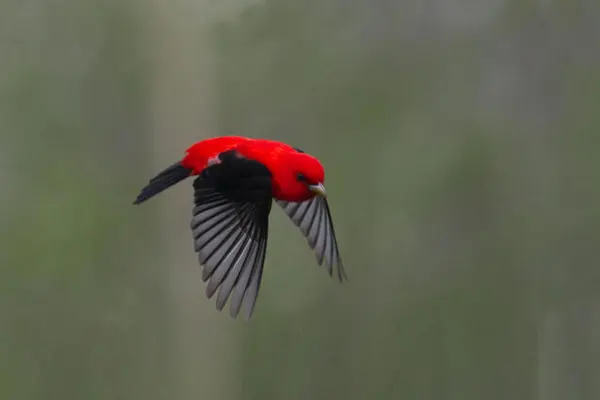

The migration patterns of the Scarlet Tanager are a remarkable example of the complex and fascinating adaptations of birds. Understanding these patterns is crucial for monitoring population trends and implementing effective conservation strategies to ensure the survival of this beautiful and important species.
Habitat & Distribution of Scarlet Tanager
Scarlet Tanagers primarily inhabit deciduous and mixed forests during the breeding season. They show a preference for mature forests with a dense canopy, providing suitable nesting sites and a rich supply of insects, which form a significant part of their diet. These forests may include oak, maple, and beech trees. However, during migration and on their wintering grounds, they can be found in a variety of forested habitats, including tropical and subtropical forests.
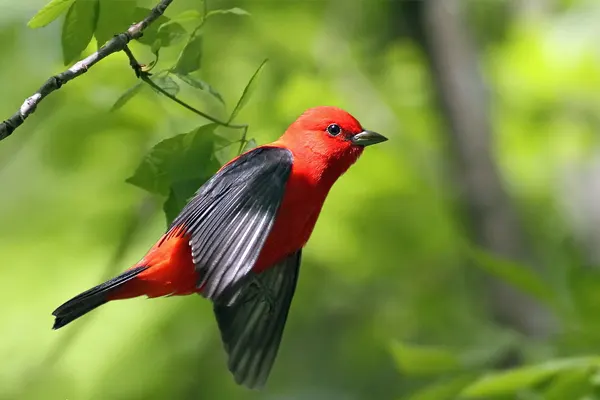

Distribution
- Breeding Range: Scarlet Tanagers breed in eastern North America, spanning from the eastern United States to southern Canada. Their breeding range includes states like Minnesota, Wisconsin, Michigan, and stretches south to parts of Georgia.
- Migration Corridor: During migration, Scarlet Tanagers travel southward to their wintering grounds in Central and northern South America. The migration corridor can vary, but they generally traverse through Central America and parts of northern South America.
- Wintering Range: In the winter months, Scarlet Tanagers can be found in tropical and subtropical forests of Central and northern South America. Countries such as Colombia, Venezuela, Ecuador, and Peru are among their wintering destinations.
The habitat and distribution of the Scarlet Tanager is essential for conservation efforts, as it helps identify key areas for protection and management throughout their annual life cycle. The species’ dependence on diverse forest habitats underlines the importance of maintaining healthy ecosystems across their extensive range.
Behavioral Traits of Scarlet Tanager
The behavioral traits of the Scarlet Tanager provides valuable insights into their ecology and contributes to efforts aimed at conserving their habitats and ensuring their long-term survival.
- Foraging Behavior: Scarlet Tanagers are primarily insectivorous during the breeding season, and their foraging behavior involves searching for insects, spiders, and other invertebrates in the foliage. They may also eat fruits and berries, contributing to their omnivorous diet.
- Breeding and Nesting: Scarlet Tanagers engage in courtship rituals during the breeding season. Males, with their vibrant red plumage, use visual displays and vocalizations to attract females. The females construct cup-shaped nests in the branches of trees, often situated high in the canopy, providing protection for their eggs and nestlings.
- Migratory Behavior: These birds are long-distance migrants, undertaking journeys between their breeding grounds in eastern North America and wintering grounds in Central and northern South America. They often migrate at night, using celestial cues for navigation.
- Vocalizations: Scarlet Tanagers have distinctive and clear vocalizations. Their songs are described as a series of phrases, often characterized by a hoarse, robin-like quality. They use vocalizations for communication, including defending territory, attracting mates, and maintaining contact with other individuals.
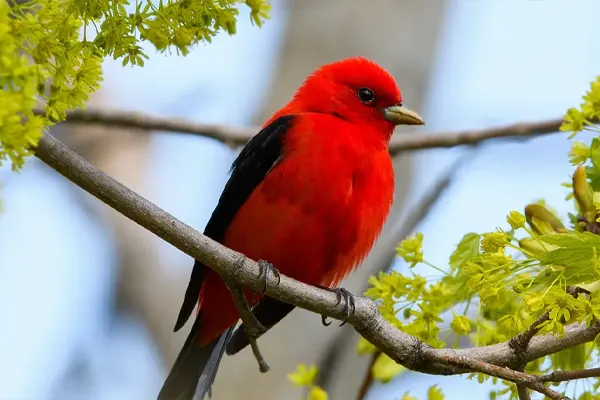
- Territorial Behavior: During the breeding season, male Scarlet Tanagers can be territorial, defending their nesting territory against intruders. This behavior is crucial for securing resources and ensuring successful reproduction.
- Social Behavior: Scarlet Tanagers are generally solitary during the non-breeding season, but they may join mixed-species flocks, particularly while foraging during migration. This behavior offers advantages such as increased foraging efficiency and improved predator detection.
- Parental Care: Both male and female Scarlet Tanagers are involved in parental care. They take turns incubating the eggs and feeding the nestlings. After the fledglings leave the nest, parental care continues as they teach their young to forage and navigate their surroundings.
Role in Ecosystem of Scarlet Tanager
The Scarlet Tanager plays a vital role in various ecosystems, contributing to predator-prey dynamics, seed dispersal, forest health, and acting as a bioindicator. Understanding these vital roles is crucial for protecting this remarkable species and ensuring the long-term health of the ecosystems it inhabits.
Predator-Prey Dynamics
- Insectivore: As primarily insectivores, Scarlet Tanagers help control insect populations in both their breeding and wintering grounds. This helps maintain ecological balance and prevents outbreaks of potentially harmful insects.
- Prey for other animals: Scarlet Tanagers are preyed upon by various birds of prey, such as hawks and owls. This contributes to the food chain and supports predator populations.

- Biodiversity: The presence of Scarlet Tanagers in a forest ecosystem contributes to overall biodiversity. The species occupies a specific niche in the ecosystem, interacting with other species, both flora and fauna. Their behavior, including foraging and nesting, influences the distribution and abundance of other organisms in their habitat.
- Forest Health: Scarlet Tanagers are associated with mature deciduous and mixed forests. The health of these forests is crucial for the well-being of the species. Their presence is an indicator of a stable and suitable habitat, and efforts to conserve Scarlet Tanager populations often involve strategies to maintain and restore the health of forest ecosystems.
- Pollination: While not primary pollinators, Scarlet Tanagers may inadvertently contribute to the pollination of flowers while foraging for nectar or insects. Their interactions with flowering plants can have subtle impacts on the reproductive success of certain plant species within their habitat.
- Indicator Species: Scarlet Tanagers can serve as indicators of ecosystem health. Changes in their population size or distribution may signal broader environmental changes, including alterations in habitat quality, climate conditions, or the presence of environmental pollutants.
By playing these roles in their ecosystem, Scarlet Tanagers contribute to the overall balance and functioning of the natural environment. Conservation efforts aimed at protecting Scarlet Tanager populations also contribute to the preservation of the ecosystems they inhabit.
Dietary Habits of Scarlet Tanager
The dietary habits of Scarlet Tanagers are closely tied to their life cycle and the seasonal availability of food resources. Their flexibility in incorporating both animal and plant matter into their diet reflects their ability to adapt to changing environmental conditions throughout the year.
- Insectivorous Diet: During the breeding season, which typically occurs in the spring and summer, Scarlet Tanagers are primarily insectivorous. They feed on a variety of insects and invertebrates, including caterpillars, beetles, ants, and spiders. This protein-rich diet is crucial for meeting the nutritional needs of both adults and nestlings.
- Fruits and Berries: While Scarlet Tanagers are mainly insectivores, they also incorporate fruits and berries into their diet, especially during the non-breeding season and migration. Consuming fruits provides an additional energy source and may contribute to their ability to sustain long flights during migration.
- Foraging Behavior: Scarlet Tanagers are adept at foraging in the treetops, where they search for insects among the leaves and branches. They may also glean insects from the undersides of leaves or catch flying insects in mid-air. Their foraging behavior is characterized by quick and agile movements as they navigate through the forest canopy.
- Seed Dispersal: While not a primary dietary component, Scarlet Tanagers may inadvertently contribute to seed dispersal when they consume fruits. Seeds pass through their digestive system, and when the birds excrete the seeds in a different location, they contribute to the dispersal and germination of plant species.

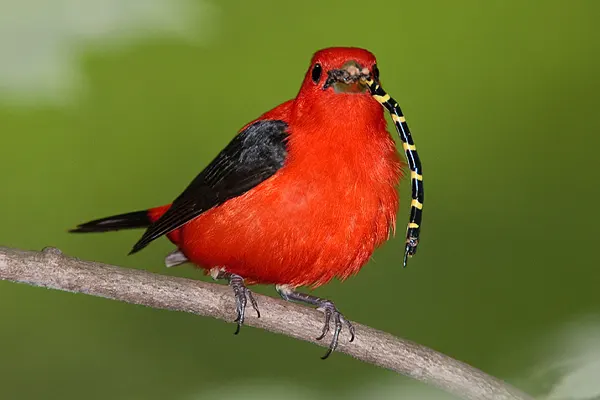
Dietary Adaptations
- Bill: The Scarlet Tanager’s bill is slightly hooked and pointed, ideal for catching and eating insects.
- Sharp eyesight: They have excellent eyesight, allowing them to spot insects from a distance.
- Agile flight: Their agile flight allows them to maneuver quickly and catch insects in mid-air.
- Seasonality: Their diet changes with the seasons, reflecting the availability of different food sources.
The Scarlet Tanager’s diet is a fascinating example of how birds adapt to their environment and play a crucial role in maintaining the health and balance of ecosystems.
Interesting Facts of Scarlet Tanager
Striking Sexual Dimorphism
- Male Scarlet Tanagers are adorned with a vibrant red plumage, a stunning contrast to their black wings and tail.
- Females, on the other hand, are camouflaged with olive-yellow feathers, blending seamlessly into the forest foliage.
Masters of the Canopy
- Scarlet Tanagers spend most of their time high in the canopy, expertly navigating the dense foliage and branches.
- Their acrobatic flight allows them to catch insects and pluck fruits with ease.
Long-Distance Migrators
- These impressive birds undertake twice-yearly migrations, traveling thousands of miles between their breeding grounds in North America and their wintering grounds in South America.
- They primarily fly at night, navigating by the stars and the Earth’s magnetic field.
Skilled Insect Hunters
- Scarlet Tanagers are voracious insectivores, consuming a wide variety of insects like caterpillars, beetles, butterflies, and flies.
- They have exceptional eyesight and agile flight, enabling them to catch insects on the wing and glean them from leaves and branches.
Fruit-Eating Feats
- While insects are their primary food source, Scarlet Tanagers also enjoy a variety of fruits, especially during late summer and fall.
- They disperse seeds through their droppings, contributing to plant regeneration and the health of the ecosystem.

Territorial Singers:
- Male Scarlet Tanagers are known for their beautiful and complex songs, which they use to attract mates and defend their territories.
- Their songs are a series of clear, whistled notes, often repeated in a rhythmic pattern.
Environmental Indicator:
- Scarlet Tanagers are sensitive to changes in their habitat, particularly deforestation.
- Their populations can serve as an indicator of environmental health, highlighting the importance of conservation efforts.
A Symbol of Renewal:
- With their vibrant red plumage and association with spring migration, Scarlet Tanagers have become a symbol of renewal and hope.
- Their presence adds a touch of beauty and wonder to the forests they inhabit.
Resilient and Adaptable:
- Scarlet Tanagers have shown remarkable adaptability to changing environmental conditions.
- Their diverse diet and flexible foraging strategies allow them to thrive in various habitats.
A Species Worth Protecting:
- Scarlet Tanagers face various threats, including habitat loss and climate change.
- Conservation efforts are crucial to ensure their continued survival and the vibrant ecosystems they contribute to.
Nesting Habits of Scarlet Tanager
The nesting habits of Scarlet Tanagers provides insights into their reproductive strategies and the importance of suitable forested habitats for successful breeding. The elevated and concealed nesting locations contribute to the safety and protection of their eggs and nestlings from potential predators.
- Nesting Site: Scarlet Tanagers typically build their nests high in the canopy of deciduous and mixed forests. The nests are often situated on horizontal branches, forks, or near the ends of branches, providing a well-concealed and secure location.
- Nest Construction: The female Scarlet Tanager is primarily responsible for building the nest. The nest is a cup-shaped structure made of twigs, grasses, and other plant materials, and it is lined with softer materials such as fine grass, rootlets, and sometimes feathers. The outer part of the nest is often camouflaged with lichen, helping it blend with the surrounding foliage.
- Height: Scarlet Tanager nests can be located at varying heights, but they are typically positioned high in the tree canopy, often 20 to 60 feet (6 to 18 meters) above the ground. This elevation provides protection against ground predators.
- Egg Laying: The female lays a clutch of 3 to 5 eggs, and both the male and female take turns incubating the eggs. The incubation period lasts about 13 to 14 days.
- Parental Care: Both parents are involved in feeding and caring for the nestlings. They bring a diet consisting of insects, caterpillars, and other small invertebrates to the nest to provide nutrition for the growing chicks.


- Fledging: The nestlings fledge (leave the nest) about 9 to 12 days after hatching. After fledging, the parents continue to care for and feed the young birds as they learn to forage and become more independent.
- Brood Parasitism: While relatively uncommon, there have been instances of Brown-headed Cowbirds laying their eggs in Scarlet Tanager nests. The cowbird chicks may outcompete the tanager chicks for resources, highlighting a potential challenge for the nesting success of Scarlet Tanagers.
- Territorial Defense: During the nesting season, male Scarlet Tanagers can be territorial, defending their nesting area against intruders, including other birds.
Understanding the nesting habits of the Scarlet Tanager, we can better appreciate their remarkable skills and take action to protect their future.
Melodious Song & Vocalizations of Scarlet Tanager
The vocal abilities of Scarlet Tanagers are not only beautiful but also functionally important for their social interactions, breeding behaviors, and overall communication within their environment. Birdwatchers and ornithologists often appreciate the distinctiveness of their songs and calls, using them as identifiers in the field.
- Song: The Scarlet Tanager has a clear and melodious song that is often described as a series of phrases resembling the song of a robin but with a hoarser quality. The song is typically characterized by repeated phrases, and males use it for various purposes, including establishing and defending territory, attracting mates, and communicating with other individuals.
- Vocal Repertoire: In addition to their song, Scarlet Tanagers have a diverse vocal repertoire that includes various calls. These calls serve different functions, such as contact calls between mates, warning calls in response to potential threats, and communication with nestlings and other members of their social group.
- Contact Calls: Scarlet Tanagers often use contact calls to maintain communication with their mates or family members, especially when foraging or moving through the forest. These calls help individuals stay in contact and coordinate their activities.
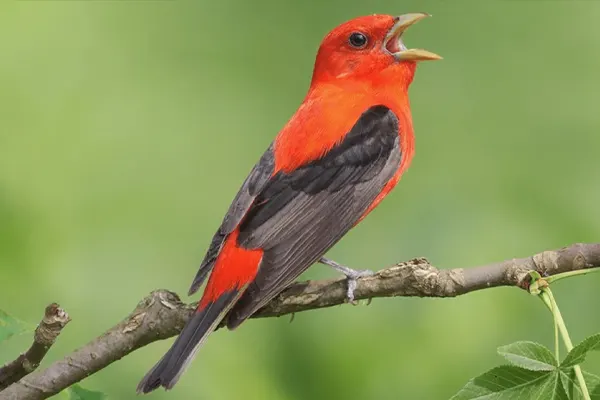
- Territorial Calls: During the breeding season, males may use specific calls to establish and defend their territory. These calls serve as a warning to other males in the vicinity and help prevent conflicts over breeding territories.
- Nesting Calls: The vocalizations of Scarlet Tanagers are also important during the nesting season. Nesting calls may be used by both parents to communicate with each other and with their nestlings. These calls play a role in coordinating activities related to feeding and caring for the young birds.
- Communication During Migration: While migrating, Scarlet Tanagers may engage in vocalizations that serve as contact calls with other members of their migratory flock. This communication is important for maintaining group cohesion during the challenging journey.
The Scarlet Tanager’s song and vocalizations are a fascinating example of avian communication. These sounds contribute to the beauty of the natural world, play a vital role in the birds’ reproductive success and survival, and provide valuable insights into their behavior and ecology.
Ecological Significance of Scarlet Tanager
The Scarlet Tanager plays a vital role in maintaining healthy and balanced ecosystems. Their contributions to predator-prey dynamics, seed dispersal, forest health, and serving as a bioindicator make them an important component of the natural world.
- Seed Dispersal: Scarlet Tanagers, while primarily insectivorous, also consume fruits and berries during certain times of the year. By doing so, they contribute to the dispersal of seeds across different locations. This helps in the regeneration and diversity of plant species within their habitat.
- Insect Control: During the breeding season, Scarlet Tanagers play a role in controlling insect populations by feeding on a variety of insects and invertebrates. This insectivorous behavior helps regulate insect numbers, preventing outbreaks of certain pest species and contributing to the overall balance of the ecosystem.
- Indicator of Forest Health: Scarlet Tanagers are associated with mature deciduous and mixed forests. Monitoring their populations can serve as an indicator of the health of these forest ecosystems. Changes in their abundance or distribution may signal broader environmental changes, such as habitat degradation or alterations in forest structure.
- Biodiversity: The presence of Scarlet Tanagers contributes to overall biodiversity in their habitat. Their interactions with other species, both flora and fauna, help maintain a diverse and interconnected ecosystem. Their specific ecological niche is part of the intricate web of relationships within the forest.

- Role in Food Web: As both predators of insects and consumers of fruits, Scarlet Tanagers occupy a specific trophic level in the food web. Their interactions with other organisms, such as insects and plants, influence the dynamics of the ecosystem.
- Contribution to Forest Regeneration: Through their feeding habits and interactions with plant species, Scarlet Tanagers indirectly contribute to the regeneration of forests. Their foraging for fruits and dispersal of seeds can play a role in the renewal of vegetation within their habitat.
- Education and Conservation: Scarlet Tanagers, as charismatic and easily recognizable species, contribute to educational and conservation efforts. Their presence can engage public interest and raise awareness about the importance of preserving natural habitats and biodiversity.
The ecological significance of the Scarlet Tanager is crucial for conservation initiatives. Protecting their habitats and ensuring the health of the ecosystems they inhabit not only benefits this species but also contributes to the overall well-being of the surrounding environment.
Conservation Status of Scarlet Tanager
The conservation status of the Scarlet Tanager is a reminder that even species with relatively large populations are not immune to the threats posed by habitat loss, climate change, and other human activities. Continuous monitoring and conservation efforts are crucial to ensure the long-term survival of this beautiful and ecologically important bird.

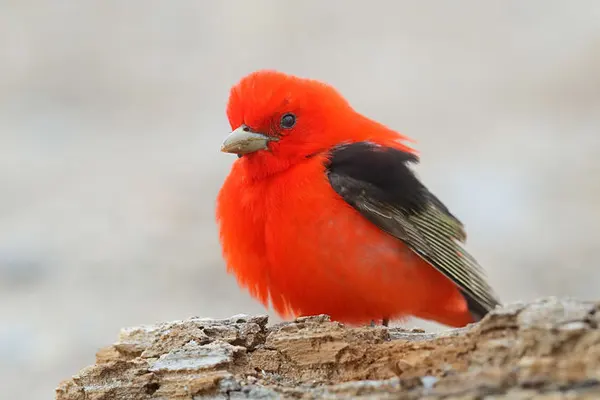
Population trends
- While the global population remains stable, there has been a decline of approximately 14% in the North American breeding population over the past 50 years.
- This decline is likely due to habitat loss and fragmentation, primarily caused by deforestation and urban development.
Habitat threats
- The loss of mature forests with large trees and dense undergrowth, which are preferred habitats for Scarlet Tanagers, is a major concern.
- Forest fragmentation isolates populations and decreases genetic diversity, which can make them more vulnerable to extinction.
Climate change
- Rising temperatures and changes in precipitation patterns can impact food availability and nesting success for Scarlet Tanagers.
- Changes in migration patterns and timing may also occur due to climate change, potentially disrupting breeding cycles and increasing vulnerability to predators.
Conservation efforts
- Protecting existing forests and restoring degraded areas is crucial for providing suitable habitat for Scarlet Tanagers.
- Sustainable forestry practices that minimize deforestation and maintain large, contiguous areas of mature forest are essential.
- Public awareness campaigns can help educate people about the importance of Scarlet Tanagers and their habitat, encouraging support for conservation efforts.
- Research and monitoring programs are necessary to track population trends, identify emerging threats, and evaluate the effectiveness of conservation strategies.
Research and Ongoing Studies of Scarlet Tanager
Despite its current status as Least Concern, numerous ongoing research efforts and studies focus on understanding the Scarlet Tanager’s ecology and addressing conservation challenges.
- Migration Ecology: Scientists are studying the detailed migration routes, stopover sites, and wintering grounds of Scarlet Tanagers. Tracking technologies, such as geolocators and satellite tags, provide valuable insights into their migratory behaviors and the challenges they face during long-distance journeys.
- Breeding Biology: Research focuses on the breeding ecology of Scarlet Tanagers, including nesting habits, mate selection, and factors influencing reproductive success. Monitoring nesting sites and studying parental care behaviors contribute to a better understanding of their breeding biology.
- Habitat Use and Preferences: Studies investigate the species’ habitat preferences during different seasons, including breeding, migration, and wintering. Understanding the specific requirements for foraging, nesting, and roosting helps guide conservation efforts aimed at preserving suitable habitats.
- Climate Change Impacts: Researchers are exploring how climate change may affect Scarlet Tanager populations. This includes assessing potential shifts in their distribution, changes in timing related to breeding and migration, and the overall impact of climate-related factors on their survival.

- Genetics and Population Genetics: Genetic studies contribute to understanding the population structure, genetic diversity, and connectivity among Scarlet Tanager populations. This information aids in assessing the health and resilience of different populations.
- Conservation Strategies: Conservation initiatives involve collaborative efforts among researchers, conservation organizations, and policymakers. Research on Scarlet Tanager populations informs the development of effective conservation strategies, including habitat preservation, management practices, and mitigating potential threats.
Educational and Ecotourism of Scarlet Tanager
The educational and ecotourism potential of the Scarlet Tanager, we can create a win-win situation for both people and nature. By educating the public and promoting responsible tourism, we can ensure the continued existence of this magnificent bird and the ecosystems it depends on.
Educational Resources
- Birdwatching: Observing Scarlet Tanagers in their natural habitat is an educational experience for people of all ages. Their distinctive plumage, songs, and behaviors can be used to teach about bird identification, adaptations, and ecological roles.
- School programs: Educational programs can be developed around the Scarlet Tanager, incorporating topics like bird anatomy, migration, and the importance of habitat conservation.
- Citizen science: Participating in citizen science projects, such as bird counts and nest box monitoring, provides valuable data for researchers and allows individuals to contribute to the conservation of Scarlet Tanagers.
- Museums and nature centers: Educational exhibits and presentations can showcase the Scarlet Tanager’s unique characteristics and ecological contributions.
- Online resources: Numerous websites and educational platforms offer information about Scarlet Tanagers, making the learning process accessible to a wider audience.

Ecotourism Opportunities
- Birdwatching tours: Guided tours specifically focused on observing Scarlet Tanagers can attract bird enthusiasts and nature lovers.
- Wildlife photography workshops: Workshops can teach individuals how to capture the beauty of Scarlet Tanagers in photographs, promoting appreciation for the species.
- Birdwatching festivals: Events celebrating birds and their conservation, such as birding festivals, can raise awareness and promote ecotourism opportunities.
- Eco-lodges and nature retreats: Providing opportunities for visitors to experience the natural world and observe Scarlet Tanagers in their habitat can promote sustainable tourism practices.
- Responsible tourism initiatives: Educating visitors about responsible tourism practices and minimizing the impact on the environment and wildlife are crucial for ensuring the sustainability of ecotourism.
Essential that educational and ecotourism activities involving Scarlet Tanagers prioritize ethical and sustainable practices to minimize potential impacts on the birds and their habitats. Conservation-focused initiatives can play a crucial role in ensuring the long-term well-being of Scarlet Tanager populations and their ecosystems.
Conclusion
The Scarlet Tanager is a truly fascinating bird, captivating us with its vibrant plumage, intricate songs, and remarkable ecological contributions. Its journey from the lush forests of North America to the tropical havens of South America and back demonstrates the wonders of migration and the interconnectedness of the natural world.
From its role in controlling insect populations and dispersing seeds to its function as a bioindicator and symbol of renewal, the Scarlet Tanager plays a crucial role in maintaining healthy and balanced ecosystems. While currently listed as Least Concern, ongoing research and conservation efforts are crucial to ensure the future of this magnificent species.
By appreciating the beauty and significance of the Scarlet Tanager, we can become stewards for its protection. Engaging in educational programs, participating in citizen science initiatives, and supporting responsible ecotourism opportunities are all ways we can contribute to the conservation of this remarkable songbird and ensure its vibrant melody continues to echo through our forests for generations to come.


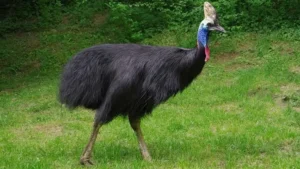
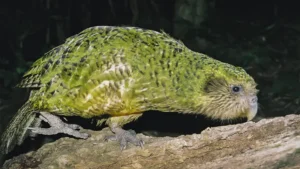
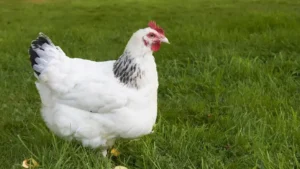
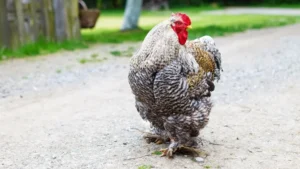
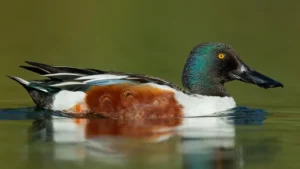



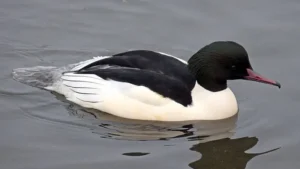
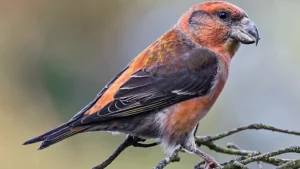


Leave your comment